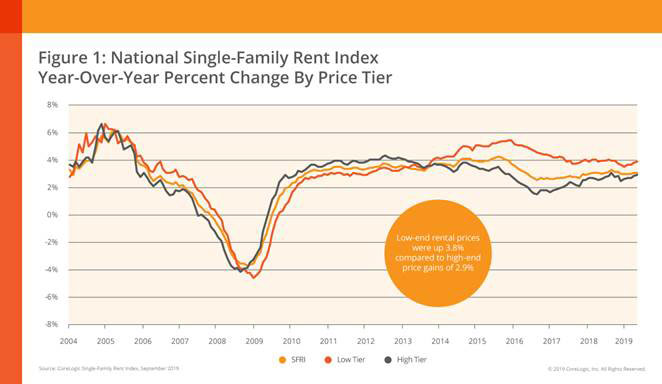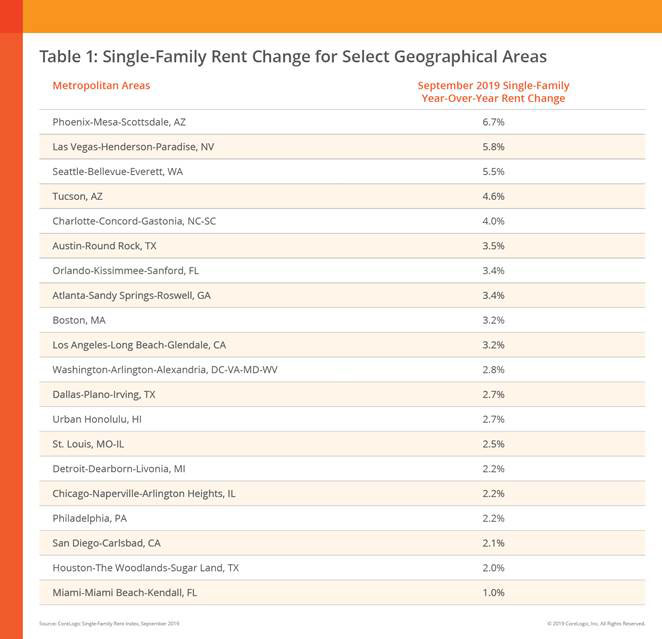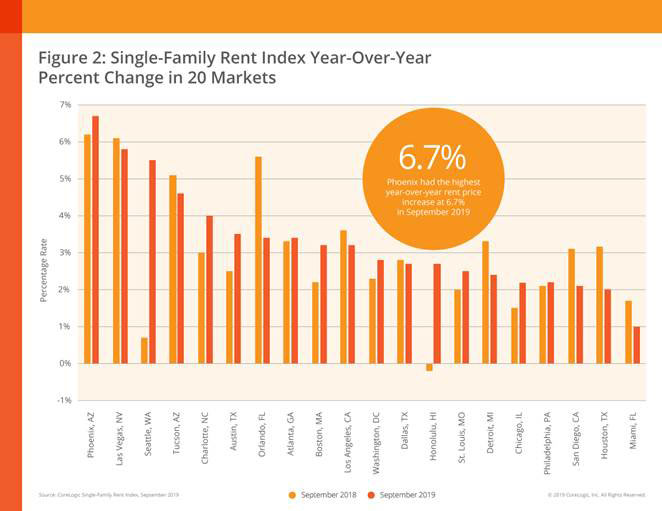The WPJ
THE WORLD PROPERTY JOURNALReal Estate Facts Not Fiction
Residential Real Estate News

Single-Family Rents Rise 3 Percent Annually in U.S.
Residential News » Irvine Edition | By WPJ Staff | November 26, 2019 8:00 AM ET
CoreLogic's newly released Single-Family Rent Index (SFRI) -- which analyzes single-family rent price changes nationally and among 20 U.S. metropolitan areas -- shows a national rent increase of 3 percent in September 2019, which remained flat in comparison to September 2018.
Low rental home inventory, relative to demand, fuels the growth of single-family rent prices. The SFRI shows single-family rent prices have climbed between 2010 and 2019. However, overall year-over-year rent price increases have slowed since February 2016, when they peaked at 4 percent, and have stabilized around 3 percent since early 2019.
September marked the 65th consecutive month in which low-end rentals propped up national rent growth. Rent prices among this tier, defined as properties with rent prices less than 75 percent of the regional median, increased 3.8 percent year over year in September 2019, the same as in September 2018. Meanwhile, high-end rentals, defined as properties with rent prices greater than 125 percent of a region's median rent, increased 2.9 percent in September 2019, up from a gain of 2.5 percent in September 2018.
Among the 20 metro areas shown in Table 1 below, and for the tenth consecutive month, Phoenix had the highest year-over-year increase in single-family rents in September 2019 at 6.7 percent (compared to September 2018), followed by Las Vegas at 5.8 percent. Seattle outpaced Tucson, Arizona, as the third-highest metro for rent growth in September with gains of 5.5 percent, while Miami experienced the lowest rent increases of all analyzed metros at 1 percent.
Metro areas with limited new construction, low rental vacancies and strong local economies that attract new employees tend to have stronger rent growth. Phoenix experienced high year-over-year rent growth in September, driven by the annual employment growth of 2.4 percent. This is compared with the national employment growth average of 1.4 percent, according to data from the United States Bureau of Labor Statistics. Seattle also experienced an elevated annual employment growth of 3.3 percent, which played a role in its above-average, year-over-year rent increase in September.
"Low rental supply coupled with ongoing demand pushed up rents in September," said Molly Boesel, principal economist at CoreLogic. "Vacancy rates have fallen moderately on the national level over the last quarter - with a 0.3 percent decrease in the third quarter of 2019 compared to a year earlier - and more significantly in select metro areas. Of the metros analyzed in the CoreLogic Single-Family Rent Index, Phoenix experienced the largest decrease in vacancy rates at 2.6 percent, which helped drive its rent growth to the top of the nation in September."

Low rental home inventory, relative to demand, fuels the growth of single-family rent prices. The SFRI shows single-family rent prices have climbed between 2010 and 2019. However, overall year-over-year rent price increases have slowed since February 2016, when they peaked at 4 percent, and have stabilized around 3 percent since early 2019.
September marked the 65th consecutive month in which low-end rentals propped up national rent growth. Rent prices among this tier, defined as properties with rent prices less than 75 percent of the regional median, increased 3.8 percent year over year in September 2019, the same as in September 2018. Meanwhile, high-end rentals, defined as properties with rent prices greater than 125 percent of a region's median rent, increased 2.9 percent in September 2019, up from a gain of 2.5 percent in September 2018.
Among the 20 metro areas shown in Table 1 below, and for the tenth consecutive month, Phoenix had the highest year-over-year increase in single-family rents in September 2019 at 6.7 percent (compared to September 2018), followed by Las Vegas at 5.8 percent. Seattle outpaced Tucson, Arizona, as the third-highest metro for rent growth in September with gains of 5.5 percent, while Miami experienced the lowest rent increases of all analyzed metros at 1 percent.
Metro areas with limited new construction, low rental vacancies and strong local economies that attract new employees tend to have stronger rent growth. Phoenix experienced high year-over-year rent growth in September, driven by the annual employment growth of 2.4 percent. This is compared with the national employment growth average of 1.4 percent, according to data from the United States Bureau of Labor Statistics. Seattle also experienced an elevated annual employment growth of 3.3 percent, which played a role in its above-average, year-over-year rent increase in September.
"Low rental supply coupled with ongoing demand pushed up rents in September," said Molly Boesel, principal economist at CoreLogic. "Vacancy rates have fallen moderately on the national level over the last quarter - with a 0.3 percent decrease in the third quarter of 2019 compared to a year earlier - and more significantly in select metro areas. Of the metros analyzed in the CoreLogic Single-Family Rent Index, Phoenix experienced the largest decrease in vacancy rates at 2.6 percent, which helped drive its rent growth to the top of the nation in September."

Sign Up Free | The WPJ Weekly Newsletter
Relevant real estate news.
Actionable market intelligence.
Right to your inbox every week.
Real Estate Listings Showcase
Related News Stories
Residential Real Estate Headlines
- U.S. New-Home Sales Surge in August as Mortgage Rates Ease
- Despite Increased Foreign Buyer Activity, Miami Residential Sales Dip 11 Percent in August
- California Home Sales Enjoy Modest Uptick as Mortgage Rates Ease
- U.S. Home-Flipping Profits Sink to Lowest Level Since 2008 Financial Crisis as Costs Climb
- Why the World's Rich Are Flocking to Europe in 2025
- Federal Reserve Delivers First Rate Cut of 2025 as Mortgage Relief Proves Limited
- Homebuilder Sentiment Holds Steady in U.S. as Rate-Cut Bets Lift Outlook
- U.S. Mortgage Rates Experience Sharpest Weekly Drop in Over a Year
- U.S. Foreclosures Rise for Sixth Straight Month as Affordability Pressures Mount
- Black U.S. Homeownership Rate Falls to Two-Year Low as Job Losses Mount
- Las Vegas Home Prices Flatten as Listings Surge, Sales Slow
- Cooling Miami Housing Market Sees 16 Percent Annual Sales Drop in July
- U.S. Mortgage Delinquencies Uptick in June Amid Regional Pressures
- California, Florida Top U.S. Housing Markets Most at Risk of Downturn
- 30-Year Mortgage Drops to 6.56 Percent in Late August, Lowest Since October 2024
- Investors Maintain Elevated Role in U.S. Housing Market Despite Slight Pullback
- Pending Home Sales Show Mixed Signals as U.S. Buyers Remain Cautious
- Canadian Home Sales Extend Recovery in July
- U.S. Home Sales Rise in July as Buyers Gain More Bargaining Power
- Zombie Foreclosures Edge Up Across U.S.
- 2.6 Million Homes at Wildfire Risk Across 14 Western States in 2025
- One in Five Americans Willing to Trade Personal Safety for Home Affordability
- U.S. Home Price Growth Slows as Affordability Pressures Mount in 2025
- U.S. Mortgage Rates Dip to Four Month Low in Early August
- U.S. Mortgage Applications Rise in Late July, Breaking Four-Week Slump
- Hong Kong's Housing Market Stuck in Stalemate as Bulls and Bears Face Off
- U.S. Condo Market Struggles in 2025
- U.S. Pending Home Sales Remain Sluggish in June
- Los Angeles Area Wildfires Destroyed Nearly $52 Billion in Homes Last January
- Greater Palm Beach Area Residential Sales Slip in June Amid Growing Inventory
- Economic Resilience Lifts U.S. Housing Outlook Going Forward
- New Home Sales Stagnate as Affordability Struggles Continue in America
- U.S. Housing Market Slips in June as Prices Hit New Highs
- Florida, California Continue to Reign Supreme as America's Ultraluxury Housing Markets
- Caribbean Housing Market Evolves into Global Second-Home Hotspot
- U.S. Home Sales See Highest June Cancellation Rate on Record
- Orlando Housing Market Cools in June as Listings Slide, Sales Slow
- Private Credit Surges in 2025 as Real Estate Developers Bypass Banks
- U.S. Condo Market Suffers Sharpest Price Drops in Over a Decade as Buyers Retreat
- Rising Taxes, Insurance Costs Undermine the Stability of U.S. Homeownership
Reader Poll
Marketplace Links
This website uses cookies to improve user experience. By using our website you consent in accordance with our Cookie Policy. Read More









